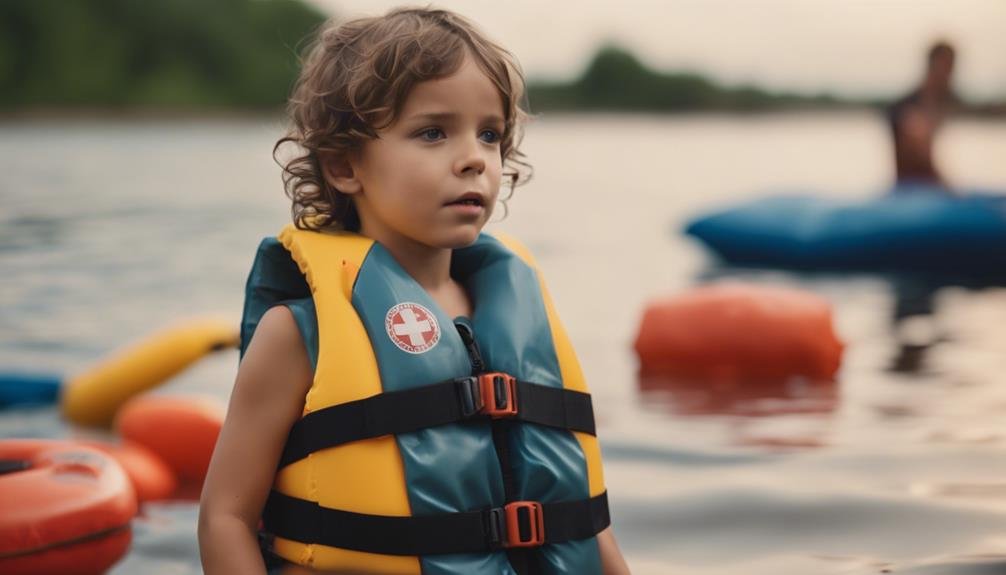"Cherishing Little Steps - A Haven for Baby and Family Journeys"
The Importance of Water Safety for Young Children
As a parent, you might have heard about the tragic incident where a young child drowned in a backyard pool during a family gathering. It is important to understand the significance of water safety for young children to prevent such heartbreaking accidents.
In this discussion, we will explore the risks associated with water-related incidents and how supervision, teaching essential water safety skills, ensuring the proper use of life jackets, and being prepared for emergencies can play an essential role in safeguarding your child's well-being near water.
Key Takeaways
- Constant supervision near water is crucial for preventing water-related accidents.
- Teach children water safety skills early to empower them for safe water activities.
- Always wear a properly fitting life jacket to enhance safety near water bodies.
- Conduct emergency drills and establish safety protocols to be prepared for water-related crises.
Risks of Water-Related Accidents
Water-related accidents pose significant dangers to young children, emphasizing the importance of vigilance and preventive measures. Drowning prevention is essential, and ensuring water awareness is crucial for the safety of your little ones. Children are naturally drawn to water, making it essential to establish clear rules and boundaries around water bodies. Educate your child about the risks of water and the importance of never entering the water unsupervised.
When near pools, lakes, or any water source, always maintain constant supervision. Equip your child with essential swimming skills and the knowledge of how to stay safe in and around water. Implement barriers such as pool fences and alarms to prevent unauthorized access. Remember, even shallow water can pose a risk to young children, so never underestimate the potential danger.
Teach your child to respect water and always emphasize the importance of following safety guidelines. By instilling these principles early on, you empower your child to enjoy water activities safely. Stay vigilant, stay informed, and prioritize water safety for your little one's well-being.
Importance of Supervision
Ensuring constant supervision around water sources is important to safeguarding your child's well-being and preventing potential accidents. Proper supervision is key to drowning prevention and should never be underestimated. When your child is near any body of water, whether it's a pool, bathtub, or natural water source, always keep a watchful eye on them. Remember, accidents can happen in a matter of seconds, so being present and attentive is essential.
To provide proper supervision, avoid distractions like phone calls or conversations that take your focus away from your child. Stay within arm's reach of your child if they're in or around water, especially if they're inexperienced swimmers. It's also essential to never leave them unattended, even for a brief moment.
Teaching Water Safety Skills

As your child grows and becomes more comfortable around water, it's important to start teaching them essential water safety skills to further enhance their protection and confidence.
Here are some key ways to help your child develop these important skills:
- Swim Lessons: Enrolling your child in swim lessons at an early age can greatly improve their water safety skills. Professional instructors can teach them proper swimming techniques and how to stay safe in the water.
- Safety Rules: Establish clear safety rules for your child to follow whenever they're near or in the water. This could include never swimming alone, always having adult supervision, and understanding the importance of pool fences and gates.
- Practice Water Safety Drills: Regularly practice water safety drills with your child, such as how to float on their back or how to safely exit a pool. By rehearsing these drills, your child will be better prepared in case of an emergency.
Teaching these water safety skills early on won't only protect your child but also empower them to enjoy water activities safely.
Proper Use of Life Jackets
Make sure to always wear your life jacket correctly when near water to ascertain your safety. Proper fit is important for life jackets to function effectively. When putting on a life jacket, make sure it's snug but not too tight, with all buckles fastened securely. A properly fitting life jacket shouldn't ride up past your ears or chin when in the water. Adjust the straps to achieve a comfortable fit that allows for easy movement without compromising safety.
Understanding buoyancy control is also essential. Life jackets are designed to keep you afloat, but it's important to know how to position your body to stay safe in the water. If you need to remain still, keep your head tilted back to help you float. In case you need to swim, practice using your legs to stay afloat while keeping your head above water.
Emergency Preparedness

To be truly prepared for emergencies near water, understanding and practicing quick, decisive actions are essential. In moments of crisis, being equipped with the right knowledge and skills can make all the difference. Here are some key points to contemplate when it comes to emergency preparedness:
- Emergency Drills: Regularly conducting emergency drills with your family can help everyone understand what needs to be done in case of an emergency. Practice scenarios like someone falling into the water or getting caught in a strong current.
- Safety Protocols: Establish clear safety protocols for your family whenever you're near water. This could include designating a meeting point in case someone gets separated or ensuring everyone knows how to call for help.
- Communication: Effective communication is vital during emergencies. Teach your children how to calmly and clearly communicate their location and the issue at hand to adults or emergency services.
Frequently Asked Questions
What Are Some Common Misconceptions About Water Safety for Young Children?
You might think kids are always safe with lifeguards or floaties, but they still need supervision. Swimming lessons are key. Remember, barriers around pools are essential too. Stay vigilant and informed to keep them safe.
How Can Parents Effectively Communicate the Importance of Water Safety to Their Children?
You can effectively communicate the importance of water safety to your children by engaging in role-playing scenarios and using visual aids. These interactive methods make learning fun and help kids understand essential safety rules.
Are There Any Specific Water Safety Tips for Children With Special Needs or Disabilities?
When helping children with special needs or disabilities stay safe in water, seek inclusive programs and specialized training. Use adaptive equipment and consider sensory needs. Prioritize their safety, comfort, and enjoyment in aquatic activities.
What Are Some Lesser-Known Signs of Distress or Drowning That Parents Should Be Aware Of?
When near water, watch for subtle signs of distress. Early intervention saves lives. Look for silent struggles, not just splashing and yelling. Prevention is key. Stay vigilant, be aware. Your attention matters.
How Can Parents Create a Water Safety Plan for Their Family Beyond Just Supervision and Teaching Skills?
When creating a water safety plan, think about emergency preparedness and prevention strategies. Utilize water safety gadgets and technology advancements to enhance protection. Stay vigilant and proactive to keep your family safe around water.
Conclusion
To sum up, remember that water safety for young children is like being their lifeguard in the unpredictable ocean of life. Stay vigilant, teach them important skills, guarantee they wear life jackets, and be prepared for emergencies.
By taking these simple steps, you can help keep your little ones safe and sound while they enjoy the wonders of water. Stay proactive, stay informed, and most importantly, stay safe.


